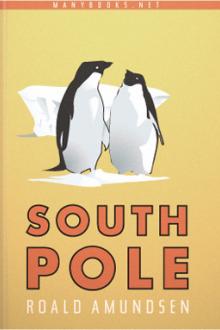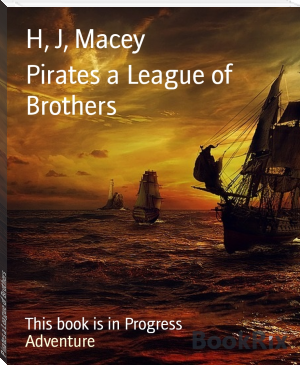The North Pole by Robert E. Peary (room on the broom read aloud .TXT) 📕

- Author: Robert E. Peary
- Performer: -
Book online «The North Pole by Robert E. Peary (room on the broom read aloud .TXT) 📕». Author Robert E. Peary
"Mac, who had never before shot anything larger than a bird, was cool, and his automatic was going off like a pom-pom, when we cut loose on the charging trio. Their numerous companions added to the general din; and the reports of the rifles, the shouts and pounding of the Eskimos, with the bellowing of the infuriated animals, sounded like Vesuvius blowing its head off. We sank one walrus, then disabled another; but the biggest one dived and came up with a snort right alongside of the boat, so that he blew water in our faces. With our guns almost touching his head, we let drive—and he began to sink. With a triumphant cheer, the Eskimos harpooned him.
"Then we signaled to the Roosevelt to come up, and as soon as the friends and neighbors of the deceased smelled the smoke, they made for parts unknown.
"In this hunt, as in all other walrus hunts I was in, I had a hard time in trying not to take a crack at the floats. They were black, and jumped around in the weirdest way, so that they appeared to be alive. I knew that if I shot one, I would never hear the last of it, so took good care.
"Another time we went for a herd of fifty-odd walruses that were sleeping on the ice. The wind was blowing fairly hard, and it is never easy to shoot accurately from a whale-boat which is doing a cake-walk in the arms of a choppy sea. When we got twenty yards from the ice cake, we began to fire. I hit a couple of walruses, but did not kill them, and with fierce grunts the huge brutes wriggled into the sea. They were coming our way, and all hands stood by to show the visitors how we loved to speed the parting guest—our way of showing this being the vocal and instrumental method already described.
"Wesharkoopsi, an Eskimo, who stood right behind me and who had been telling us what an expert he was with the harpoon, was making threatening gestures which boded ill for any walrus that came near us.
"Suddenly, with a loud 'Ook! Ook!' a bull rose like a giant jack-in-the-box right alongside of me, giving us a regular shower bath, and he got both tusks on the gunwale of the boat.
"Wesharkoopsi was not expecting a fight at such close quarters, and he got badly rattled. Instead of throwing his harpoon he dropped it, yelled madly, and began to spit in the monster's face. It is needless to state that we never again took Wesharkoopsi walrus-hunting in a whale-boat.
"The others were shouting, swearing in English and Eskimo at Wesharkoopsi, the walrus, and everything in general; some were trying to hit the brute, others to back water.
"I was not eager just then to test the soundness of one arctic explorer's dictum: 'If a walrus gets his tusks over the side of the boat, you must not hit him, as such a course would induce him to back water and upset you; but gently grasp the two-thousand-pound monster by the tusks and drop him overboard'—or words to that effect. If this one had got his tusks a quarter inch further my way, he would have had them clear over the gunwale; so I held my rifle at port arms, stuck its business end into the visitor's face, and let him have it—which settled his account.
"That walrus had tried to upset us, but almost immediately another one tried a new variation of the game, an almost successful effort to sink us—a regular dive-tackle.
"He was a large bull that an Eskimo had harpooned. He showed what he was made of by promptly attacking the float and putting it out of commission, then he proceeded to make off with the harpoon, float, and all. He happened to come near my end of the boat, and I shot at him; but whether I hit the mark or not I do not know. Anyhow, he dived, and while we were all looking over the side for him to appear, our craft was hit a tremendous whack by something under the stern—so hard that it upset the bosun, who was standing there peacefully sculling.
"Our friend was getting a little too strenuous; but he dived before I could shoot again, and came up fifty yards off. Then I hit him with a bullet, and he disappeared. Maybe we were not an anxious crowd in that boat for the next few minutes, as we knew that that submarine earthquake was due for another blow-up at any instant—but when and where! We stared at the surface of the water, to see if possible from what direction the next attack would come.
"One more such scrimmage as the last and we would be all in—both literally and metaphorically; for he had put a big hole through the bottom of the boat, and as she had a double bottom we could not check the leak, and one man had to bale rapidly. We always carried along a lot of old coats to stop holes in the boats, but in this case they might as well have been pocket handkerchiefs.
"Suddenly an Eskimo who was looking over the side yelled: 'Kingeemutt! Kingeemutt!' ('Back her! Back her!') But the words were hardly out of his mouth when—smash! rip! bang!—the stern of the boat rose under the shock, the bosun was nearly knocked overboard, an Eskimo catching him on the fly, and a hole I could have put both fists through suddenly appeared within an inch of his foot, just above the water line.
"I looked over the gunwale. There the brute lay on his back, tusks upright under the stern; then with a quick flop he dived. The men did their usual stunts to scare him off. Up he came fifteen yards away, gave his battle-cry, 'Ook! Ook! Ook!' to warn us to look out for trouble, and came tearing along the surface of Whale Sound like a torpedo boat destroyer, or an unmuffled automobile with a bicycle policeman on its trail.
"I got my rapid-fire gun into the game and sank him; then we made for the nearest cake of ice—and reached it none too soon."
To take up the story where Borup leaves it, when the first wounded walrus had been despatched with a bullet, and the floats were all taken in, an oar was erected in the boat for a signal, and the Roosevelt steamed up. The floats and the lines were taken over the rail of the ship, the walrus raised to the surface of the water, a hook inserted, and the winch on deck hoisted the monster on board, to be later skinned and cut up by the expert knives of the Eskimos. While this work was going on, the deck of the ship looked like a slaughterhouse, with the ravenous dogs—at this stage of the journey we had already about one hundred and fifty—waiting, ears erect and eyes sparkling, to catch the refuse thrown them by the Eskimos.
In the Whale Sound region we sometimes obtained narwhal and deer, but there was no narwhal hunting to speak of on the upward journey this last time. Walrus, narwhal, and seal meat are valuable food for dogs, but a white man does not usually enjoy it—unless he is nearly starved. Many times, however, during my twenty-three years of arctic exploration, I have thanked God for even a bite of raw dog.
CHAPTER X KNOCKING AT THE GATEWAY TO THE POLEFrom Etah to Cape Sheridan! Imagine about three hundred and fifty miles of almost solid ice—ice of all shapes and sizes, mountainous ice, flat ice, ragged and tortured ice, ice that, for every foot of height revealed above the surface of the water, hides seven feet below—a theater of action which for diabolic and Titanic struggle makes Dante's frozen circle of the Inferno seem like a skating pond.
Then imagine a little black ship, solid, sturdy, compact, strong and resistant as any vessel built by mortal hands can be, yet utterly insignificant in comparison with the white, cold adversary she must fight. And on this little ship are sixty-nine human beings, men, women, and children, whites and Eskimos, who have gone out into the crazy, ice-tortured channel between Baffin Bay and the Polar Sea—gone out to help prove the reality of a dream which has bewitched some of the most daring minds of the world for centuries, a will-o'-the-wisp in the pursuit of which men have frozen, and starved, and died. The music that ever sounded in our ears had for melody the howling of two hundred and forty-six wild dogs, for a bass accompaniment the deep, low grumbling of the ice, surging around us with the impulse of the tides, and for punctuation the shock and jar of our crashing assaults upon the floes.
We steamed northward into the fog beyond Etah, Greenland, on the afternoon of August 18, 1908. This was the beginning of the last stage of the Roosevelt's journey. All now on board would, if they lived, be with me until my return the following year. As an ungentle reminder of what was ahead of us, though going at half speed because of the fog, we struck a small berg a little way out from the harbor. Had the Roosevelt been an ordinary ship instead of the sturdy ice-fighter that she is, my story might have ended right here. As it was, the shock of the impact jarred things considerably. But the berg suffered more than the ship, which only shook herself like a dog coming out of the water, and with the main mass of the berg swaying heavily on one side from the blow we had given it, and a large fragment we had broken off churning the water on the other side, the Roosevelt scraped between them and went on.
This little incident made a strong impression on the new members of my party, and I did not think it necessary to tell them that it was only a mosquito bite to the crunching and grinding between the jaws of the heavier ice that was in store for us a little farther on. We were working in a northwesterly direction toward the Ellesmere Land side, and headed for Cape Sabine, of terrible memories. As we steamed on, the ice became thicker, and we had to turn south to get out of the way of it, worming our course among the loose floes. The Roosevelt avoided the heavier ice; but the lighter pack she shoved aside without much difficulty. South of Brevoort Island we were fortunate in finding a strip of open water, and steamed northward again, keeping close to the shore.
It must be remembered that from Etah to Cape Sheridan, for the greater part of the course, the shores on either side are clearly visible,—on the east the Greenland coast, on the west the coast of Ellesmere Land and Grant Land. At Cape Beechey, the narrowest and most dangerous part, the channel is only eleven miles wide, and when the air is clear it almost seems as if a rifle bullet might be fired from one side to the other. These waters, save in exceptional seasons, are filled with the heaviest kind of ice, which is constantly floating southward from the Polar Sea toward Baffin Bay.
Whether this channel was carved in the solid land by the force of pre-Adamite glaciers, or whether it is a Titanic cleft formed by the breaking off of Greenland from Grant Land, is a question still undetermined by





Comments (0)